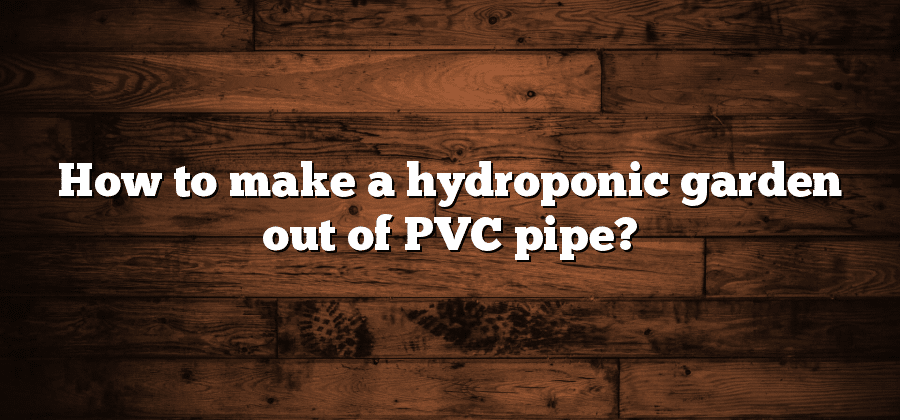Understanding the Basics of Hydroponic Gardening
Hydroponic gardening is a modern technique that enables plants to grow without the use of soil. Instead, nutrients are directly delivered to the plants through a water solution. This method offers various advantages over traditional soil-based gardening, including better control over growing conditions, higher yield potential, and the ability to grow plants in limited spaces.
One of the key principles of hydroponic gardening is maintaining the proper balance of nutrients in the water solution. In this method, essential nutrients such as nitrogen, phosphorus, and potassium are dissolved in water, creating an optimal environment for plants to thrive. By delivering nutrients directly to the root system, plants are able to absorb them more efficiently, resulting in faster growth and healthier plants. Additionally, the absence of soil eliminates the risks of soil-borne diseases and pests, making hydroponic gardening a cleaner and more sustainable option for cultivating plants.
Selecting the Right Materials for Your PVC Pipe Hydroponic Garden
Selecting the right materials for your PVC pipe hydroponic garden is crucial to ensuring its success. When it comes to choosing the PVC pipes, it is important to opt for ones that are durable, sturdy, and resistant to moisture. Look for pipes that are specifically designed for outdoor use and have UV protection to prevent them from deteriorating under sun exposure. Additionally, consider the size and diameter of the pipes, as this will determine the amount of water flow and nutrient distribution within your hydroponic system.
In addition to pipes, you will also need to carefully select the fittings and connectors for your hydroponic garden. It is recommended to choose fittings that are compatible with the size of your PVC pipes and provide a tight and secure connection. This will help prevent any leaks and ensure that water and nutrients are distributed properly throughout the system. Additionally, consider using durable materials such as PVC cement or glue to further secure the connections and enhance their longevity. By carefully selecting the right materials for your PVC pipe hydroponic garden, you can lay a solid foundation for a successful and efficient growing experience.
Preparing and Cutting the PVC Pipes for Assembly
Before assembling your hydroponic garden using PVC pipes, it is essential to properly prepare and cut the pipes to ensure a secure and efficient system. To begin, gather all the necessary tools, including a saw or pipe cutter, measuring tape, and sandpaper.
First, measure and mark the desired length of each pipe segment, ensuring precision and accuracy. Keep in mind the layout and dimensions of your garden design as you make these measurements. Using a saw or pipe cutter, carefully cut each pipe segment to the specified length, making sure to maintain straight and clean cuts. Once the pipes are cut, use sandpaper to smooth any rough edges or burrs, ensuring a seamless fit when assembling the system. Remember, precise preparation and cutting of the PVC pipes is crucial for the stability and functionality of your hydroponic garden.
Building the Frame for Your Hydroponic Garden Using PVC Pipes
To build a sturdy and reliable frame for your hydroponic garden using PVC pipes, you will need a few key materials and some basic knowledge of assembly. PVC pipes are an excellent choice for constructing the frame due to their affordability, durability, and versatility. Before beginning the construction process, ensure that you have all the necessary supplies, including PVC pipes, connectors, a tape measure, a saw, and a rubber mallet.
The first step in building the frame is to measure and cut the PVC pipes to the desired length. Using a tape measure, carefully mark the dimensions of each section of the frame and use a saw to make clean and precise cuts. It is important to ensure that all the pipes are cut to the correct measurements to ensure a snug fit when assembling the frame. Once the pipes are cut, dry-fit them together to confirm that the frame is coming together as planned and make any adjustments if necessary. Remember, a strong and stable frame is crucial for supporting the weight of the plants and the hydroponic system, so take your time in this step to ensure the structural integrity of your garden.
Creating the Water Reservoir and Pump System
To create an efficient hydroponic garden, it is crucial to establish a functional water reservoir and pump system. The water reservoir holds and circulates the nutrient solution throughout the garden, providing the plants with the necessary nutrients for their growth and development. When selecting a water reservoir, it is important to choose a durable and food-safe container that is large enough to accommodate the number of plants you intend to grow. Common options include plastic bins, buckets, or even specially-designed water tanks.
Once you have chosen a suitable water reservoir, the next step is to install a pump system. The pump is responsible for circulating the nutrient solution from the reservoir to the plants, ensuring a constant flow of nutrients and water. When selecting a pump, consider factors such as water capacity, power consumption, and noise level. It is recommended to choose a pump that is specifically designed for hydroponic systems, as these are usually more efficient and reliable. Additionally, it is essential to regularly clean and maintain the pump to prevent clogging and ensure optimal performance.






